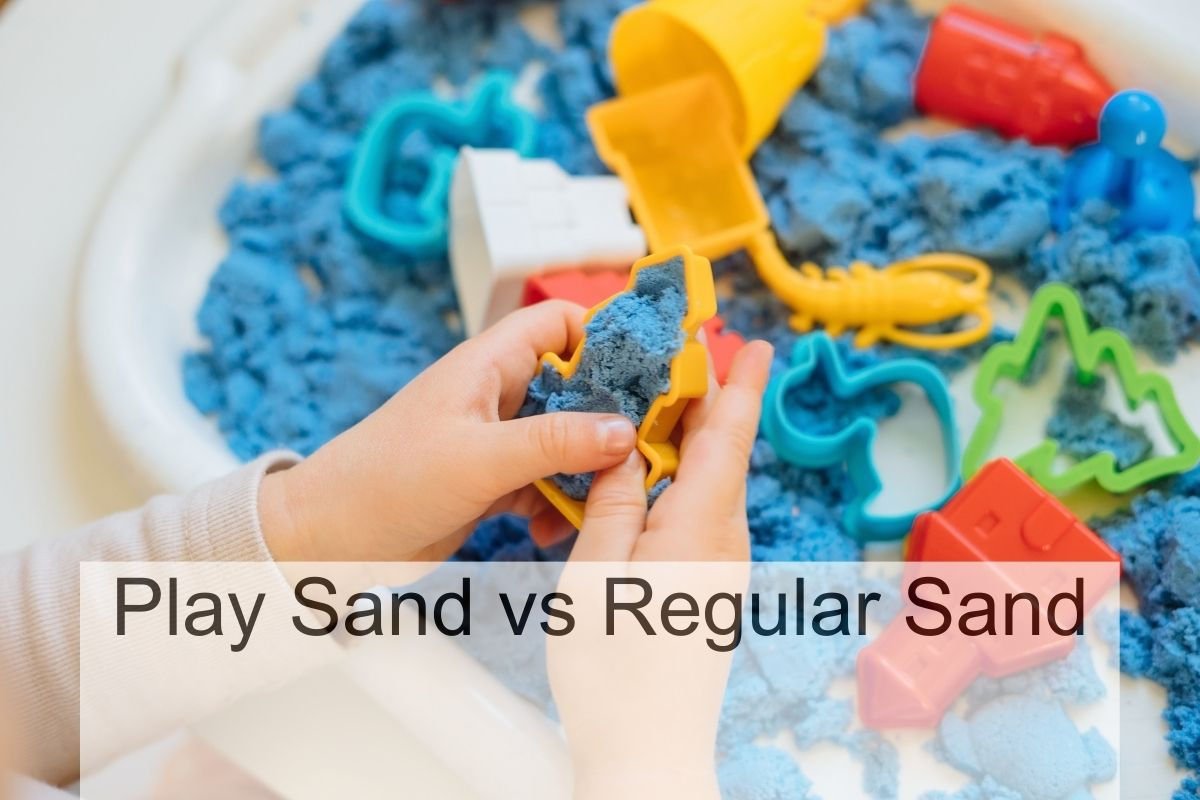When it comes to creating a sandbox for your kids, choosing the right type of sand is crucial. Play sand and regular sand are two common options, but they have significant differences that can impact your child’s safety and enjoyment. As a parent, I want to ensure that my child’s playtime is both fun and safe, so I decided to research the differences between play sand and regular sand.

Firstly, play sand is specifically designed for children’s play areas and is thoroughly cleaned and sifted to remove any impurities. On the other hand, regular sand is not subject to regulations and is not prepared for play. It may contain harmful substances such as silica dust, which can cause respiratory problems if inhaled. Additionally, regular sand can be rougher and coarser than play sand, which can cause skin irritation and scratches on your child’s delicate skin.
Defining Play Sand and Regular Sand

When it comes to choosing between play sand and regular sand, it’s important to understand the differences between the two. Play sand is specifically designed for children’s play areas, such as sandboxes and play pits. It is cleaned and sifted to remove any impurities that may be harmful to children. Play sand is also finer and softer than regular sand, making it easier to shape and mold.
On the other hand, regular sand is typically used for construction and landscaping projects. It may contain impurities such as rocks, dirt, and debris, and is not designed for use in children’s play areas. Regular sand is coarser and harder than play sand, which can make it more difficult for children to play with.
It’s important to note that not all regular sand is created equal. Some types of regular sand may be cleaner and safer than others. However, it’s always best to err on the side of caution and choose play sand for children’s play areas.
Key Differences Between Play Sand and Regular Sand

When it comes to choosing the right sand for your children’s play area, there are some key differences between play sand and regular sand that you should be aware of.
1. Cleaning Process: Play sand is thoroughly cleaned and sifted before it is packaged and sold, whereas regular sand is not subject to regulations and is not prepared for play. This means that play sand is free of any harmful contaminants, making it safer for children to play with.
2. Grain Size and Shape: Play sand is made of much finer grains that are more rounded in shape, making it ideal for sandboxes, sand tables, and playgrounds. Regular sand, on the other hand, is coarser and contains a lot more dust, which can make it harmful to your children. Playing in it can leave kids feeling itchy and even covered in scratches.
3. Price: Play sand is typically more expensive than regular sand. You can find regular bulk sand for as cheap as $25 to $50 per ton, while play sand can cost as much as $15 for 5 pounds.
Safety Concerns and Toxicity

When it comes to choosing between play sand and regular sand, safety is a major concern. Regular sand may contain harmful substances such as crystalline silica, which can cause serious respiratory problems when inhaled. On the other hand, play sand is generally considered safe for children to play with, as it is typically free of harmful substances.
It is important to note that not all play sand is created equal. Some play sand products may still contain silica dust, which can be harmful when inhaled. It is recommended to choose play sand that is labeled as “silica-free” or “safe sand” to ensure that it is free of harmful substances.
In addition to silica dust, regular sand may also contain other harmful substances such as bacteria and parasites. It is important to properly clean and maintain any sand play area to prevent the growth of harmful organisms. This includes regularly raking the sand to remove debris and foreign material, as well as covering the sand when not in use to prevent moisture buildup.
Best Uses for Play Sand

When it comes to sand play, play sand is the way to go. It is specifically designed for children’s play and has many benefits over regular sand. Here are some of the best uses for play sand:
- Sandbox: Play sand is perfect for setting up a sandbox for your kids. It is clean, safe, and free of any harmful chemicals or substances. Plus, it is soft and easy to mold, making it perfect for building sandcastles and other structures.
- Sand Table: Another great use for play sand is in a sand table. Sand tables are a great way for kids to explore and experiment with sand without making a mess. Play sand is easy to clean up and won’t leave a residue on your floors or furniture.
- Arts and Crafts: Play sand is also great for arts and crafts projects. You can use it to make sand art, sand candles, and other fun projects. It is easy to color and has a great texture that kids will love.
Best Uses for Regular Sand
As I mentioned earlier, regular sand is not recommended for use in sandboxes or for children’s play areas. However, it has many other uses that make it a valuable resource.
Regular sand is commonly used in construction and landscaping projects. It is often used as a base material for paving stones or as a filler material in concrete. It can also be used to level out uneven ground or to create a base for a garden or flower bed.
Another common use for regular sand is in sandblasting. Sandblasting is a process used to clean or prepare surfaces for painting or other finishes. The sand is blasted at high pressure onto the surface, removing any dirt, rust, or old paint.
Regular sand can also be used as a natural abrasive. It is often used to sand wood or other materials by hand, or in a sanding machine. It is a cost-effective alternative to other types of sandpaper and can be reused multiple times.
Physical and Chemical Properties
When it comes to physical properties, play sand and regular sand have some differences. Play sand is made of finer grains that are more rounded in shape, while regular sand is coarser and contains larger particles. This difference in texture is important because it affects how the sand feels and how easy it is to work with. Play sand is smoother and easier to shape, making it ideal for building sandcastles and other structures. Regular sand, on the other hand, is rougher and harder to shape, but it can be useful for landscaping and other outdoor projects.
In terms of chemical properties, play sand and regular sand are similar. Both are made primarily of silica, which is a naturally occurring mineral that is found in many types of rock. Silica is non-toxic and does not pose any health risks when used properly. However, some types of sand may contain other minerals or substances that can be harmful to humans or the environment. For example, some types of sand may contain heavy metals or other contaminants that can leach into the soil or water supply. It’s important to choose sand that is free from contaminants and safe for use in your specific application.
Availability and Cost Comparison
When it comes to availability, both play sand and regular sand are widely available in most hardware stores and online retailers. However, play sand is specifically made for children’s play and is more commonly found in stores that cater to children’s needs.
In terms of cost, regular sand is generally cheaper than play sand. Regular sand can be bought in bulk for as low as $25 to $50 per ton, while play sand can cost up to $15 for 5 pounds. However, it’s important to note that regular sand is not subject to regulations and is not prepared for play, so it may contain harmful substances that are not safe for children to play with.
Environmental Impact
When it comes to environmental impact, there are some key differences between play sand and regular sand. Play sand is typically made from finely ground quartz crystals, which are a naturally occurring mineral. This means that it is generally considered to be safe for the environment, as it is not treated with any chemicals or other harmful substances.
Regular sand, on the other hand, can come from a variety of sources, including beaches, rivers, and quarries. While it is also a natural material, the process of extracting and transporting it can have a negative impact on the environment. For example, sand mining can lead to erosion, loss of habitat for wildlife, and even changes to the landscape.
Another factor to consider is the potential for contamination. Regular sand may contain pollutants such as heavy metals, bacteria, or other harmful substances. Play sand, on the other hand, is typically washed and sterilized before it is sold, which helps to ensure that it is free from any contaminants that could harm children or the environment.
Maintenance and Longevity
When it comes to maintenance and longevity, play sand and regular sand have some differences. Play sand is designed to be cleaner and safer for children to play with, so it tends to require more maintenance to keep it that way. Regular sand, on the other hand, may have more debris and impurities, but it is generally more durable and requires less maintenance.
To keep play sand clean, it is important to regularly sift it and remove any debris or foreign objects. It is also recommended to sanitize the sand periodically with vinegar or bleach to kill any bacteria or germs. Additionally, covering the sandbox or play area when not in use can help prevent animals from using it as a litter box and further reduce the risk of contamination.
Regular sand, on the other hand, may not require as much maintenance, but it may need to be replenished more frequently due to erosion or other factors. It is also important to note that regular sand may contain more impurities and debris, which can make it less suitable for certain uses.
Choosing the Right Sand for Your Project
When it comes to choosing the right sand for your project, there are a few key factors to consider. First, you’ll want to think about the purpose of the sand. Are you building a sandbox for children to play in, or are you creating a decorative landscaping feature? Play sand is a great option for sandboxes and playgrounds, as it is specifically designed to be safe for children to play in. On the other hand, regular sand can be a more cost-effective option for landscaping projects.
Another important factor to consider is the texture of the sand. Play sand is typically made up of finer grains that are more rounded in shape, while regular sand can be coarser and made up of larger particles. This can impact the way the sand feels and behaves, so it’s important to choose the right texture for your project.
Additionally, it’s important to consider the quality of the sand. Play sand is typically cleaned and sifted to remove any impurities, while regular sand may not go through the same rigorous process. This can impact the safety and durability of the sand, so it’s important to choose a high-quality option for your project.

